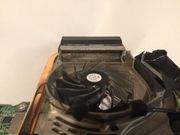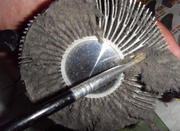Clean up! Cool down!
Your laptop may be overheating because of a fan or cooling vents clogged with dust. Here's how to set about cleaning it out.
Summary
If your laptop is overheating and the fan is running continuously, it's very likely that the cooling grill is clogged with dust. Try using a pin to poke through the grill where warm air comes out, in order to dislodge any matted dust. Then try and suck it out with a vacuum cleaner applied to the grill where the air goes in. If this doesn't work you will have to disassemble your laptop for more radical cleaning. This may seem daunting but it's not so very hard if you follow one of the many online repair guides or videos.
Safety
- Before starting work, disconnect the power and remove a user-replaceable battery if there is one.
- Consider whether you need to take antistatic precautions. Brushes and vacuum cleaners can create static.
- Airborne dust can be unpleasant and may contain allergens. You may wish to take appropriate precautions.
- If you apply a vacuum cleaner to the air vents of a laptop you will spin-up the fan and the fan motor will act as a dynamo. If you spin it unnaturally fast there is at least a theoretical possibility that the voltage generated will damage the motherboard. You may be able to prevent the fan spinning by inserting a thin screwdriver into the air inlet to lock the blades.
Background
As computers have become more powerful their central processors and other parts have consumed more electrical power. Nowadays they generally require active cooling, provided by a fan. As this draws air through the case, any dust it carries will tend to build up, impeding the air flow and reducing the cooling efficiency.
A laptop normally controls the speed of the fan according to how hard it's working and hence how much heat it's generating. But if it can't get rid of the heat because of a build-up of dust you may find the fan running at full speed all the time. The fan noise may begin to annoy you, particularly if it's starting to rub on a thick mat of dust. Worse, the computer may become unreliable, crashing or shutting down spontaneously.
In a laptop the heat is carried away from the central processor (and often one other component) by a heat pipe. This is a sealed copper tube containing a fluid which boils at the hot end and condenses at the other end, where the fan blows air over a cooling grill. A wick carries the condensed fluid back to the hot end. The cooling grill can become completely blocked by a thick mat of dust.
Desktop computers generally have a large heat sink mounted directly on the processor. This is a lump of aluminium or copper with many cooling fins and a small fan mounted directly on it to carry away the heat. The fan and the vanes can become completely choked by dust. Another fan mounted behind a cooling grill draws air through the case. This doesn't usually get clogged, but a good clean never does any harm.
A high-end gaming computer may be water cooled. Water is actively pumped through the heat sink and then through a fan-cooled radiator, where dust build-up may occur.
A gaming computer may be being overclocked (i.e. being run faster than its normal speed). This will make it more susceptible to overheating unless an extra large heat sink and fan have been fitted.
Diagnostics
It may be obvious that you have an overheating problem if the fan is running continuously or noisily, or if the computer case is getting very hot, especially if it's crashing.
If you're not sure overheating is the problem then download and install Speedfan from www.almico.com. This will give you the temperatures of your processor and hard disk. The results may be of limited value in isolation if you don't know what the temperatures should be but is well worth doing before you start any remedial action so you can compare them with the temperatures after you finish.
Simple things to try
Applying a vacuum cleaner to the inlet and outlet air vents may be all that's needed in the case of a light build-up of dust, but take care not to spin-up the fan excessively (see Safety). Maybe you can lock the fan blades with a thin screwdriver inserted through the grill to avoid this. Also, try blowing in through the air outlet, either with your own puff or with an air duster aerosol, or if you have access to one, with a compressed air hose.
However, if the dust is causing a problem then this on its own will often be insufficient. On a laptop the worst dust build-up is usually behind the cooling fins. You may be able to break up a mat of dust by poking a needle, a wire, or something similar through the fins and agitating it. Then apply the vacuum cleaner to the air inlet to try to suck the dust out the way it went in.
Internal cleaning
Laptops
In order to properly clean the fan and cooling fins of a laptop you will have to disassemble it. This may seem pretty scary if you haven't done it before but is usually quite straightforward. Search online for a disassembly guide or video for your exact model, or a similar one of the same make.
N.B. Do not detach the heat pipe from the processor unless absolutely necessary as you will have to renew the heat-conducting paste between them. This has to be applied very carefully if the processor is not to overheat. Try not to strain the heat pipe on the processor as this may break the thermal seal between them.
You may have to remove the motherboard in order to be able to separate the fan from the cooling fins, where the worst of the dust is likely to be. Strips of sticky tape often provide a relatively airtight seal between them. A hand-held vacuum cleaner is ideal for removing the dust, but where it's stuck to the fan blades a small brush can be useful.
Desktop Computers
Desktop computers are usually much easier to clean as the case is designed to be easily opened with no more than 2 or 3 screws and sometimes a catch. Clean out the worst of the dust with a vacuum cleaner, then use a brush or air duster aerosol to dislodge any that remains on the fan or between the heatsink fins and vacuum that out too. You may need to remove the fan from the heatsink in order to clean the fins properly.
Further Information
The slides from Ben Skidmore's illustrated presentation on 2014-11-13 are referenced below.
- Main presentation:
- Working with heatsinks and replacing the thermal compound
External links
- The video How To Apply Thermal Paste shows what happens when several methods to apply thermal past are used. It is clear that the pea method as explained by Ben in his presentation is best.
- Artic Silver Application methods for applying thermal compound to Intel® CPU
- Artic Silver Application methods for applying thermal compound to AMD® CPU

